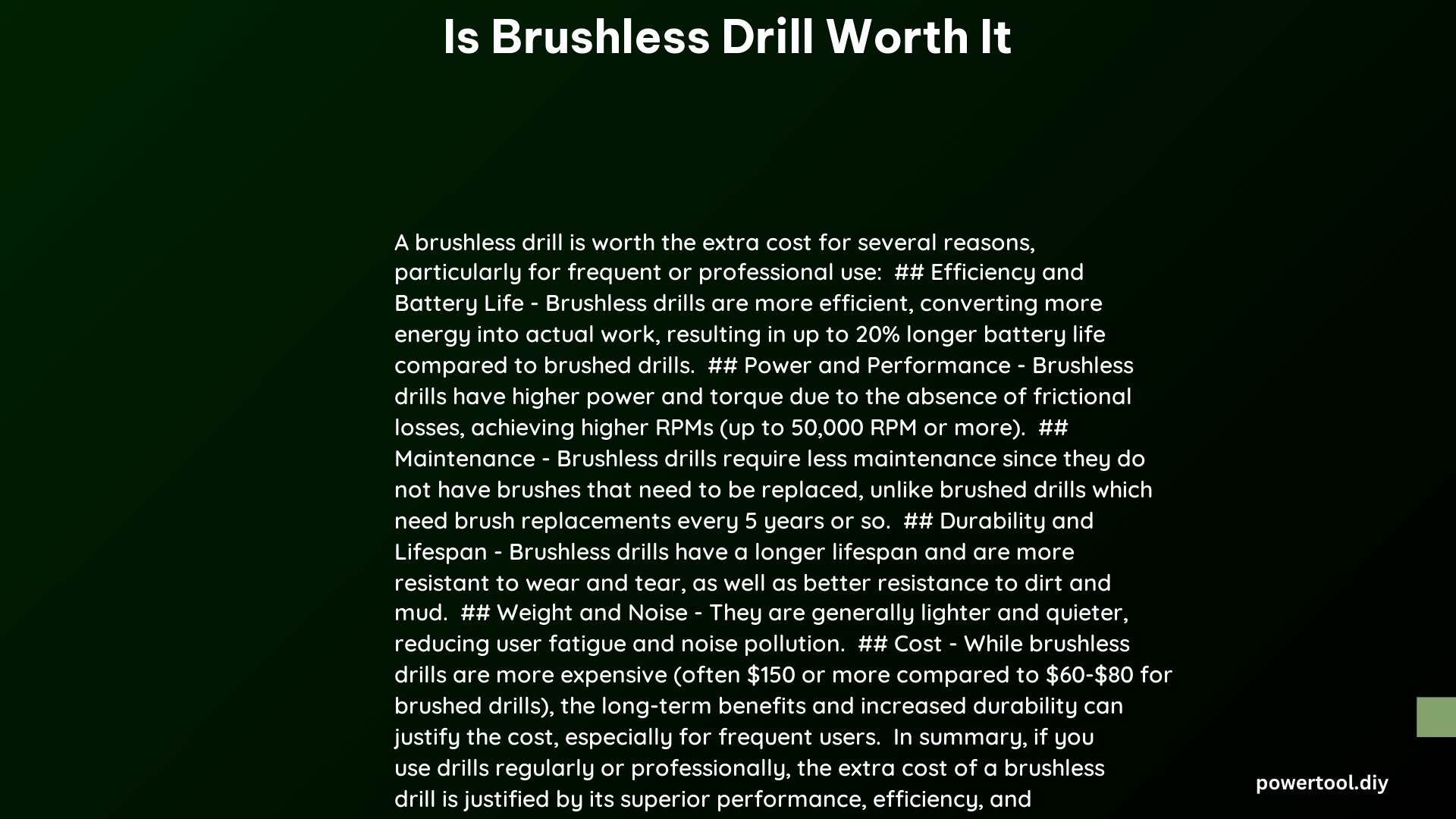Brushless drills offer superior performance, longer battery life, and reduced maintenance compared to brushed drills. While more expensive upfront, they provide long-term savings through increased efficiency and durability. Brushless motors deliver higher torque, better speed control, and improved energy efficiency, making them ideal for demanding tasks and frequent use. This article explores the key factors to consider when determining if a brushless drill is worth the investment.
What Are the Key Differences Between Brushless and Brushed Drills?
Brushless and brushed drills differ in several important aspects:
- Motor Design:
- Brushless: Uses electronic commutation
-
Brushed: Relies on physical brushes for commutation
-
Efficiency:
- Brushless: Higher efficiency due to reduced friction
-
Brushed: Lower efficiency due to brush friction
-
Maintenance:
- Brushless: Minimal maintenance required
-
Brushed: Regular brush replacement needed
-
Power Output:
- Brushless: Higher torque and more consistent power
-
Brushed: Lower torque and power fluctuations
-
Battery Life:
- Brushless: Longer runtime per charge
-
Brushed: Shorter runtime per charge
-
Cost:
- Brushless: Higher initial cost
- Brushed: Lower initial cost
How Does the Performance of Brushless Drills Compare to Brushed Drills?

Brushless drills generally outperform their brushed counterparts in several key areas:
- Torque Output:
- Brushless drills typically offer 20-30% more torque
-
Better performance in demanding applications
-
Speed Control:
- More precise speed adjustments
-
Smoother operation across different materials
-
Power Efficiency:
- Up to 50% more efficient power usage
-
Longer runtime on a single battery charge
-
Heat Generation:
- Less heat produced during operation
-
Reduced risk of motor burnout
-
Durability:
- Longer lifespan due to reduced wear and tear
- Less frequent need for repairs or replacement
What Are the Long-Term Cost Implications of Choosing a Brushless Drill?
While brushless drills have a higher upfront cost, they often prove more economical in the long run:
- Initial Investment:
- Brushless drills can cost 20-50% more than brushed models
-
Premium features and advanced technology contribute to higher price
-
Maintenance Costs:
- Brushless drills require minimal maintenance
-
No need for brush replacements, saving $20-$50 per replacement
-
Battery Life:
- Extended battery life reduces the frequency of battery replacements
-
Potential savings of $50-$100 per year on battery costs
-
Tool Longevity:
- Brushless drills typically last 2-3 times longer than brushed models
-
Reduced need for tool replacement, saving hundreds of dollars over time
-
Energy Efficiency:
- Lower power consumption can lead to savings on electricity bills
- Especially beneficial for heavy users or professional settings
How Do Brushless Drills Perform in Different Materials?
Brushless drills excel in various materials due to their advanced motor technology:
| Material | Performance | Advantages |
|---|---|---|
| Wood | Excellent | – Precise speed control for clean holes – High torque for large diameter bits |
| Metal | Superior | – Consistent power for smooth drilling – Less heat generation, reducing bit wear |
| Masonry | Very Good | – High torque for penetrating tough surfaces – Better control in hammer drill mode |
| Plastic | Good | – Adjustable speed to prevent melting – Precise torque control for delicate materials |
What Are the Maintenance Requirements for Brushless Drills?
Brushless drills require minimal maintenance compared to brushed models:
- Cleaning:
- Regular cleaning of vents and chuck
-
Removal of dust and debris after use
-
Lubrication:
- Occasional lubrication of moving parts
-
Follow manufacturer’s recommendations
-
Battery Care:
- Proper storage and charging practices
-
Avoid extreme temperatures
-
Chuck Tightening:
- Periodic check and tightening of the chuck
-
Ensure secure bit holding
-
Inspection:
- Regular visual inspection for wear or damage
- Check for loose screws or connections
Who Benefits Most from Investing in a Brushless Drill?
Brushless drills are particularly beneficial for:
- Professional Contractors:
- Heavy daily use requires durability and efficiency
-
Higher performance justifies the investment
-
DIY Enthusiasts:
- Frequent home projects benefit from longer battery life
-
Versatility for various materials and tasks
-
Woodworkers:
- Precise control for intricate work
-
Consistent power for large projects
-
Metalworkers:
- High torque for drilling through tough metals
-
Reduced heat generation for better bit life
-
Construction Workers:
- Durability for harsh job site conditions
- Powerful performance for demanding tasks
In conclusion, brushless drills are worth the investment for users who require high performance, durability, and efficiency. While the initial cost is higher, the long-term benefits in terms of performance, maintenance savings, and tool longevity make them a smart choice for both professionals and serious DIY enthusiasts.
References:
1. JCB Buying Guides: Choosing a Brushed or Brushless Drill
2. The Garage Journal: Brushless vs brush motors in drills
3. BISON: Brushed or Brushless Drill: Choosing the Right Tool?
